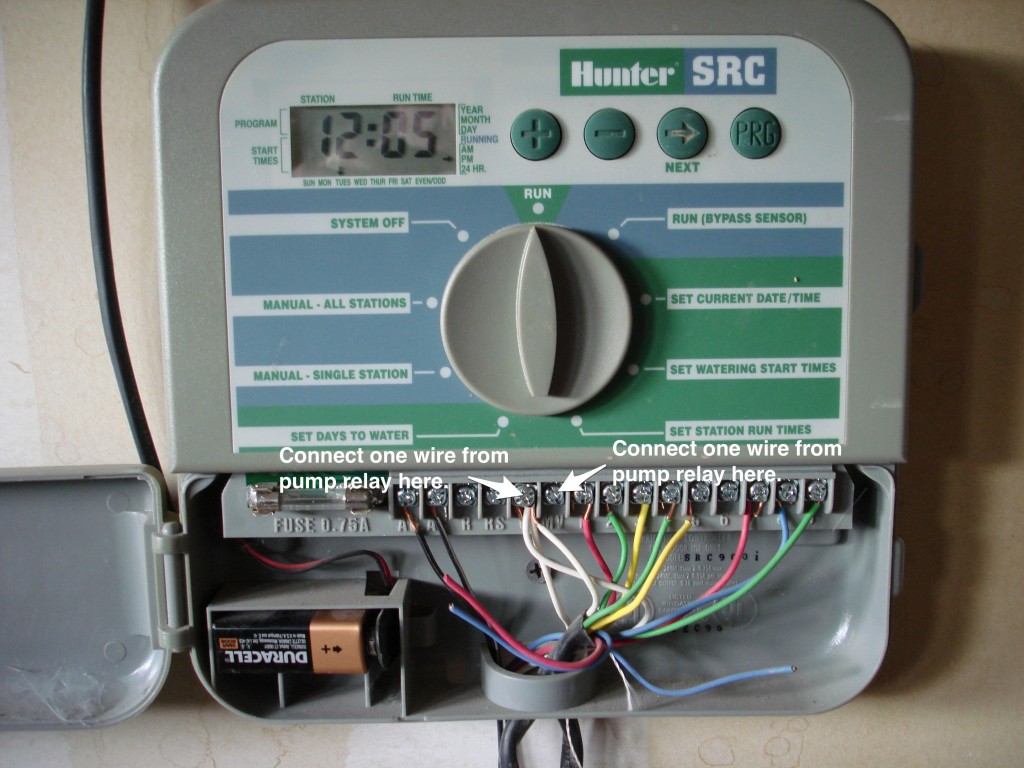Many sprinkler systems require that the timer supply power to a relay in order to send power to a sprinkler pump. Often the sprinkler system is using secondary water and is not connected to the culinary water running to the house. And many times the secondary water is supplied at very low pressures requiring the addition of a sprinkler pump.
The way this works is:
- The wires from the relay are connected to the master valve circuit on the timer (see photo). One wire to the MV or master valve terminal, and one wire to the common terminal. When the timer activates it sends power to the relay.
- When the relay receives power it closes the contacts and power is then sent to the pump to activate. Most pumps are pre-wired for 230 volts, but the selector on the pump can be changed to use 110 volts. It is very important when wiring a pump to be certain which is being delivered to the pump, 110 or 230 volts. If the wiring is wrong you could end up burning up a pump, and they are not cheap. A common 1.5hp sprinkler pump can run as much as $400-$600. Yes I know you can buy one from the home improvement stores for $199, but my experience is that they only last a few years and then the expense of a new pump and installation costs start all over again.
- At the same time the timer/controller is sending power to the sprinkler pump, it is also sending power to the sprinkler valve and opening the valve. So when the pump pressures up the system the sprinkler zone is open and waiting for the water.
- When the cycle is complete and the timer shuts off the power to the sprinkler valves, it is simultaneously shutting of the power to the relay and the pump. It varies from timer to timer, but most Master/Pump circuits are on by default on the sprinkler timer/controller.
- Below is a typical drawing and description of a Hunter SRC series timer Master/Pump valve wiring. Most sprinkler timers will be similar to this example.
- Route wires from the master valve or pump start relay location into the controller with the valve wires.
- Connect either wire from the pump relay to the MV terminal. Connect remaining wire to the C (common) terminal.



We had our drip worked on and added a zone. Now the drip in our front yard does not shut off. We have changed all valves and solenoids. I think it’s a wiring problem. What got wired incorrectly? Thank you
You can test the power at the sprinkler valve to see if it’s wired incorrectly. Manually start the station and test power at the sprinkler valve. When power at the timer shuts off for the station it should shut off power at the sprinkler valve.
Have you tried turning down the flow control at the sprinkler valve? On some drip systems the amount of water being used isn’t enough for the sprinkler valve to shut off. Sometimes turning down the flow control on the sprinkler valve will cure the problem. Manually start the station at the timer then turn the station off. If the sprinkler valve didn’t shut off then turn the flow control clockwise on the sprinkler valve slowly until it shuts off. Start and stop again at timer to confirm the sprinkler valve works properly.
We moved into our house a year and a half ago with this exact system pictured already installed into the house. It has worked fine in the past. I turned the system to off over the winter. Today I went to turn on the sprinklers, turned the knob, and it did nothing – continues to say off – we even replaced the 9volt battery. What could be the issue as we have no clue?
Thank you
Sounds like outlet to the timer isn’t supplying 120 volts. It could also be a bad transformer.
I have a 1997 hunter SRC that I am replacing with x-core because the push buttons are finicky lately.. I have wires connected to both of the AC terminals (one has 2 red, one has 2 white) I have one wire connected to the “R” terminal and I don’t know what it is for. I have 2 wires connected to the RS and one to the C, none to the MV. Why might I have extra wires? All I have is a rain sensor and I have 7 zones which each have one wire. I don’t know where to put all these wires on the new x-core which has less terminals. The AC adapter is already wired to it. I have photos if anybody wants to see…
I think you might be hitting a snag because the wiring for the rain sensor on the SRC timer is a bit different than the rain sensor wiring on the X-Core timer. Could you find the make/model of the rain sensor, number and color of wires from the sensor, and send it to me? Looks like the “R” terminal is used for a remote on the SRC. Red and white wires for the remote to the AC terminals and the blue wire to the “R” terminal. Do you have the remote and do you want to keep using it?
Thanks and Hi, in my SRC the wire for the sensor is sort of clear/tan…like speaker wire if you know what I mean. I doubt there is a model number visible after all these years, but it is mounted too high to see. Amazingly it still works so we figured we’d keep using it if possible (it is the original one!) It goes to RS and C on my SRC controller
I didn’t realize there was a remote, but after reading about it I went and looked outside and found out there is one. I guess the company who installed it put it on, but we haven’t used them in many years. I don’t know how it would benefit us, it is just outside the garage door where the controller is mounted in the garage. Is there any reason to use it? I assume those wires are what is causing my confusion? I have a pic but don’t know if I can post it…
I would leave the remote wires unconnected on the new timer. The X-Core manual (page 11) shows connecting the two rain sensor wires to the “SEN” terminals. Be sure to remove the jumper wire between the terminals.
a controller that will support a pump and a master valve thx
response does not answer my question…or maybe it does…….there is no such
controller. thx
is there a controller that will support a pump AND a master valve ?
Most sprinkler timers have master valve terminals that will run a sprinkler pump. The wires from these terminals go to a relay. When the sprinkler timer activates a sprinkler zone the master valve terminals send power to the relay which starts the sprinkler pump.
i know this……….is there a controller that will support a master valve AND a pump…
i have been dealing with sprinkler systems since the 70’s…………..again
master valve AND a pump thx
I don’t know of one. Output power on a sprinkler timer is 24 volts and most sprinkler pumps would require either 120 or 240 volts. That’s probably why you don’t see a sprinkler controller that would start a pump.
I have a Hunter Pro-C I replaced the pump start relay. I am having problems with the wiring
I believe I have most connections correct. But I am unsure about the leads from the controller. Cannot find any diagram showing these. Can anyone help?
One wire to the relay connects to the Master Valve terminal on the timer, and the other wire to the relay connects to the Common terminal on the timer.
We have a Hunter Pro-C controlier.
We also had sod installed 7-27-2012.
Does this system have a New lawn setting and if so how do you get to it.
Thank you, Tom and Linda Fish
I don’t know of any timer that has a new lawn setting. My suggestion is to set up timer for new sod watering by doing the following:
1. Put the new sod watering on its own program.
2. Turn all the water days on this program ON.
3. Use all 4 start times on the program. When I do new sod I set the start times at: 8am, 1pm, 6pm, & 1am. This way I’m watering more during the day when the sun is out and turf dries out faster.
4. I usually set the station run time from 8-12 minutes (double this if your new sod is being watered by rotors). You will have to tweak this on your sod depending on the soil type. You want the sod to stay moist for a couple of weeks until the roots start setting.
Let me know how this works.
Interesting. I love the idea of a timer like this. Having a nice irrigation system gives you one less thing you have to worry about. I’ll take that!
Bruce@ Outdoor Sprinkler Systems
We are having a problem with this kind of timer. The fuse keeps blowing. We have replaced valves that were leaking hoping that would solve the problemm but it still occurs. We need help. Not sure what to try next.
Normally a short in the solenoid on a sprinkler valve is what causes the fuse on the timer to blow. It’s going to be a process of elimination to find your short. Here’s what I would do:
1. If you don’t have one buy a circuit tester. I like the digital battery powered ones that you can buy for $29-$49. You’ll probably need some more fuses also.
2. Disconnect all the station wires and common wire from the timer. If you have a pump disconnect the two wires running to the relay from the timer.
3. Manually start station 1 on the timer and use your tester (red probe on the station 1 terminal and black probe on the common terminal) to test the timer’s output. Check the output from the timer to station 1. You should be getting 24-29 volts. We’re first checking to see if there is a problem with the timer.
4. If everything checks out here, manually start and test the rest of the stations you’re using on the timer. If you get 24-29 volts on the rest of the stations you’re using, the timer is OK and we can move on.
5. Connect the valve wire from station 1 to the station 1 terminal. Connect the common wire to the common terminal. Manually start station 1 again. That station should water with no problem. If you have a pump let me know and we might have to change the troubleshooting sequence. If station 1 waters and the fuse doesn’t blow, everything from the timer to the valve is good on this station. Repeat this process for the rest of the sprinkler stations you are using on your timer until you get to the station that blows the fuse. If any station blows the fuse then there is probably a problem with the timer wire running to the valves.
6. If only one station blows the fuse, then you have found the culprit. Replace the fuse and leave this station disconnected until you solve its problem. Normally it’s a solenoid in this situation, but it could also be a short in the timer wire between the timer and the valves.
After doing this bit of troubleshooting, let me know what you find and we can decide on what needs to be done next. KT